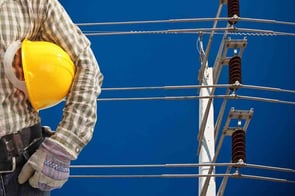Infrastructure Asset Management: Why is Joint Use Important?
 Utility poles and conduit vaults (the underground version of a wire-carrying 40-foot pole) are everywhere in our world—along highways, down neighborhood streets and under the surface of busy intersections.
Utility poles and conduit vaults (the underground version of a wire-carrying 40-foot pole) are everywhere in our world—along highways, down neighborhood streets and under the surface of busy intersections.
They carry power, communications and entertainment into our homes and businesses. Take a closer look and you will notice they also physically carry a large amount of equipment—complicated-looking metal objects of different shapes and sizes.
Those assets are the reason joint use, the sharing of infrastructure asset investments like utility poles and underground conduit between multiple parties for the greater good of the consumer, exists.
A brief history of joint use
Years ago, utility poles primarily carried power and phone lines. Our entertainment options mostly rode the airwaves to your television set, and the internet was just a gleam in an MIT professor's eye. Post 1978, however, cable companies, internet providers, and wireless and WiFi companies blossomed and vied to reach customers further and further afield. Rather than allow anyone with a signal to send to erect their own poles, joint use became an invaluable concept. Essentially the sharing of space on utility poles by a myriad of businesses, it kept our skies from becoming cluttered crisscrosses of wire and pole structures. But in its wake, new relationship rules had to be conceived.
When several entities share the same pole (attachers), each one must be able to coordinate their activities with adjacent attachers and pole owners to make sure regulatory, safety and contractual requirements are met. It amounts to sharing with structure—oversight and protocol for partnerships that have to go smoothly in order for the nation to enjoy its premium cable channels, long-distance phone calls and streaming video.
Why does the world need joint use?
In a nutshell, well-executed asset sharing means order in what is potentially a world of chaos. Without the processes, communication and collaboration that joint use enforces, a lot could happen:
- Utility poles could overload. With no communication between attachers (and between attachers and pole owners), equipment that is not structurally acceptable could end up with more equipment affixed than it can handle. Someone has to audit poles, verify their condition and keep track of who is hanging on what. Joint use sets the stage.
- Double poles could pollute our views. When a utility pole is decommissioned, another will be placed alongside to take its place. Attachers must then transfer their equipment from one pole to the other. However, without joint use agreements that define who is "next-to-go" and when, equipment movement could take forever or never happen at all.
- Backlogs could slow progress. Growth of communities, technologies and even communication companies themselves depend on each business's ability to reach consumers. When a company wants to expand its reach—whether that's farther down the road or into the next state—it must request to attach its equipment to a utility pole. Without the timelines laid out in joint use contracts, backlogs in work would run rampant (more rampant than they already do), and the next great broadband internet provider might be stopped at the border of breaking through to a whole new group of customers.
Curious about joint use and want to know more? Download our infrastructure asset management primer, Joint Use Asset Management: The Basics and dig into the details of sharing space in today's ever more complicated joint use world.
